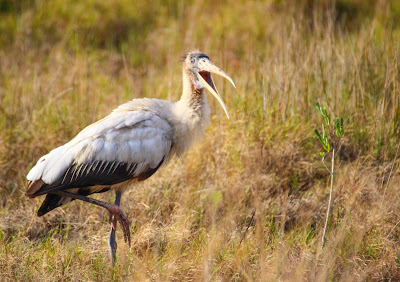I've posted on wood storks previously,
here in the Everglades and
here on Sanibel Island, but I can't resist to put up some more pictures, from Merritt Island, Circle Bar B Reserve and Orlando Wetlands.
Although in many respects these pictures are not as good as others I've taken, I've captured some things I've not seen before. In Orlando Wetlands Park there is an artificial hill called Oyler Overlook that provides a nice view of some trees that I saw filled with large white birds. I wasn't sure what kind of birds they were until I got home and was able to crop my photos: lots and lots of wood storks.
 |
| View of birds in trees from Oyler Overlook. |
 |
| Cropped view of a different photo shows wood storks, including the nice sheen on black feathers. |
Adult wood storks have a bare head and neck that are dark gray. Their plumage is white, except for some wing and tail feathers that are black with a greenish-purplish sheen. At Circle Bar B Reserve I caught an adult in flight with the sun providing the beautiful sheen on an otherwise ugly bird.
 |
| At Circle Bar B this wood stork feeds in a swampy area... |
 |
| ...then flew, revealing the sheen. |
 |
| At dusk, on my way out, I saw this stork standing high in a tree. The pink feet really stand out. |
At Merritt Island I got lots of not-so-great photos of a juvenile wood stork (although I did not realize it was a juvenile at the time - it was quite large). The juvenile has a feathered head and neck and the bill is less dark, more yellow.
 |
| This juvenile is not nearly as ugly as the older birds: it still has feathers on the head and neck. |
 |
| Note that without the sunlight, the black feathers are dark and dull. |





















































